
Chris Kyval has an effective philosophy about setting up his four-wheel drive: always utilise the available air space.
It has helped him and wife Thelma create a home away from home in their TroopCarrier, which features some very clever, but ultimately simple modifications. The 78 Series proved ideal for a two-and-a-half-month, 17,000km expedition to Australia’s most distant parts.
“Our main hobby when we travel is taking lots of photos,” Thelma says, recalling that journey from Gippsland, Victoria, up through NSW, then through South Australia via the Birdsville Track and up to WA, along the Gibb River Road, into Broome and Cape Leveque, then home along the Tanami.
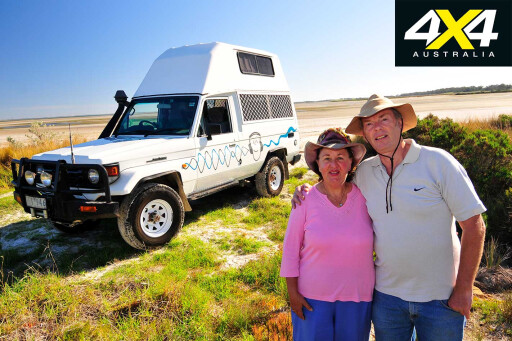 “We ended up going up over to Marree and we went via the Birdsville Track, and we saw a beautiful sunset. There was a road plant that had been parked – trucks and graders – and there was a red sunset silhouette. Although it was machinery, it was so beautiful.”
“We ended up going up over to Marree and we went via the Birdsville Track, and we saw a beautiful sunset. There was a road plant that had been parked – trucks and graders – and there was a red sunset silhouette. Although it was machinery, it was so beautiful.”
The Tojo had had two previous owners. It was originally a Britz hire car and was then owned by a guy who used it in his business for auditory hearing testing before Chris bought it from him three years ago. A television, DVD player and sound system were already in place, installed by the previous owner. The headphones painted on the side of the Troopie are also a leftover from that owner.
“I thought I’d leave that on because it looked different,” Chris says. “I simply put a smiley face in.”
 He left the engine alone, too: “A lot of Troopies have turbo-diesel, but I find it’s fine without the turbo. I’ve got everywhere I’ve wanted in it and I get very good fuel economy – two 75-litre tanks and I get exactly 600 kilometres per tank. I drive quietly.”
He left the engine alone, too: “A lot of Troopies have turbo-diesel, but I find it’s fine without the turbo. I’ve got everywhere I’ve wanted in it and I get very good fuel economy – two 75-litre tanks and I get exactly 600 kilometres per tank. I drive quietly.”
The only problem he’s had was a broken driveshaft, which was replaced by a standard-issue unit. Instead of major mechanical changes, he put his time and effort into the interior.
“There’s a lot of air space wasted in a vehicle, so what I did was use available air space and elastic clips to tie down things like paper towel, fly spray and personal insect repellent,” he says.
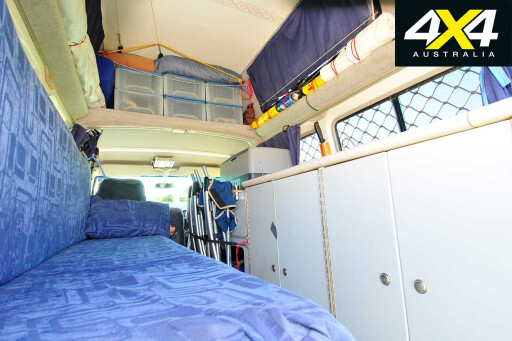 “Inside the back wall of the Troopie we made a cargo net out of straps and we were able to put in bulky items like coats, hats and umbrellas. Once again, it didn’t take up any usable space, it was at the very back wall when you climbed into the Troopie, where it’s very quick to get to. Without that you’d have to fill up a couple of wardrobes and containers.”
“Inside the back wall of the Troopie we made a cargo net out of straps and we were able to put in bulky items like coats, hats and umbrellas. Once again, it didn’t take up any usable space, it was at the very back wall when you climbed into the Troopie, where it’s very quick to get to. Without that you’d have to fill up a couple of wardrobes and containers.”
The Waeco fridge is a feature of the kitchen, which also includes a sink and a number of drawers and storage areas, cleverly created by Chris.
“Chris did lots of work because he has marvellous inspiration for those sorts of things,” Thelma says.
 A kitchen-bench lid covers the cutlery. Chris says: “Under the lid I put these clips to attach the wooden spoon, spatula and a pair of tongs, and that also used up that air space.”
A kitchen-bench lid covers the cutlery. Chris says: “Under the lid I put these clips to attach the wooden spoon, spatula and a pair of tongs, and that also used up that air space.”
Chris put a mirror on the inside of the back door. By opening the door, there’s ample space to stand in front of the glass to do your hair.
“And sometimes, when we get to a township where I want to put a bit of lippie on or something, it’s nice to have a mirror,” says Thelma.
 She applied her own handiwork skills to make pillows and handgrips in matching material. “The bed cushions, which are part of the seating arrangement first, are then laid flat and make a bed. I made the covers for those and I made an extra pillow that goes in the front seat on the door side – an extra cushion for extra comfort.
She applied her own handiwork skills to make pillows and handgrips in matching material. “The bed cushions, which are part of the seating arrangement first, are then laid flat and make a bed. I made the covers for those and I made an extra pillow that goes in the front seat on the door side – an extra cushion for extra comfort.
“I made a padded handgrip over the handrail where the passenger holds on just above the glovebox. I found that when it’s bumpy, it’s good to have something like that to hold onto."
 Velcro seems to be one of Chris’s favourite materials. He has used it throughout the cabin to attach useful objects so they’re always there when he needs them.
Velcro seems to be one of Chris’s favourite materials. He has used it throughout the cabin to attach useful objects so they’re always there when he needs them.
Both Thelma and Chris have their head lamps attached within reach of their seats. “They were always there, very safe, secure and no rattles,” says Chris.
He also attached a bottle of window cleaner by Velcro so it is always on hand. “I filled up this pump-action window cleaner, attached a strip of Velcro to it and another strip on the transmission tunnel near the floor and it’s always there; it never moved. Each morning I’d get my little cloth and clear the windscreen, have a fresh start.” And it can be so easy to misplace your tyre gauge without a good system.
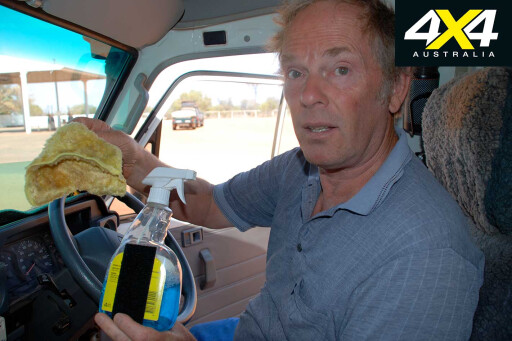 “I put a bit of Velcro just underneath my water bottle, just inside the door behind the driver’s head, and a bit of Velcro on the tyre gauge,” Chris says. “It’s very convenient. Each morning I just pull it off and check the tyres.”
“I put a bit of Velcro just underneath my water bottle, just inside the door behind the driver’s head, and a bit of Velcro on the tyre gauge,” Chris says. “It’s very convenient. Each morning I just pull it off and check the tyres.”
Chris used pushbike technology and screwed bicycle water-bottle holders above the driver and passenger doors. “They were screwed to the pillar, out of the way, using up air space again, and when you’re driving along you have your water right there,” Chris says.
With everything working well inside the box, Chris only needed to play around the edges of the Troopie’s mechanicals. First came suspension.
.jpg ) “Anyone who thinks they can make do with old suspension is really deluding themselves,” he says. “It’s an item in a vehicle that takes a punishing, especially in a 4X4. You don’t get so fatigued, it’s safer, more comfortable and tyres last longer.
“Anyone who thinks they can make do with old suspension is really deluding themselves,” he says. “It’s an item in a vehicle that takes a punishing, especially in a 4X4. You don’t get so fatigued, it’s safer, more comfortable and tyres last longer.
“I have Pedders’ Trak Ryder shockers – they are top-of-the-range shock absorbers and I wanted to improve the handling. I also put in rear air bags; you can raise or lower the suspension. If you have a lot of weight in the back you can make the vehicle level. Once they were put on, it just drove like a new car – it made a huge difference.”
Until recently, Chris stuck with the standard split rims. On that last trip, he copped five flats and had no trouble removing the tyres and repairing the inner tubes, but when he came home he decided on a set of Sunraysias so he could go with tubeless rubber.
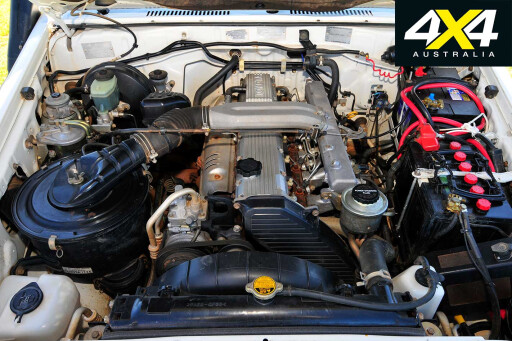 “The advantage of the tubeless is that if you get a slow leak all you need to do is pump it up or find the hole and insert a temporary plug until you get to the service station and have it done correctly.
“The advantage of the tubeless is that if you get a slow leak all you need to do is pump it up or find the hole and insert a temporary plug until you get to the service station and have it done correctly.
“I went for Goodyear Wrangler tyres – there was a little trick with this, too. I bought the Wranglers made in America because the compound is superior to the ones made in other, third-world countries. Also, the Wranglers have what they call Silent Armor, a Kevlar material that helps prevent punctures.”
The bullbar was on the Toyota when Chris bought it, but it was winchless. At first, that wasn’t a worry, but their second expedition made the couple reassess their entire recovery set-up.
“What made us change a couple of things was when we went to Cameron Corner, the border crossing between South Australia, NSW and Queensland,” Chris says. “We camped on the side of the road one night and it started to rain. The next day the roads were very difficult to drive on.”
 The police, in the process of closing the roads, gave them permission to retrace their steps towards Broken Hill, but it was a hairy drive. “We were very lucky to get through because we were slipping on the muddy, unsealed roads, so I decided when I got home I would fit a 3.5-tonne electric winch.”
The police, in the process of closing the roads, gave them permission to retrace their steps towards Broken Hill, but it was a hairy drive. “We were very lucky to get through because we were slipping on the muddy, unsealed roads, so I decided when I got home I would fit a 3.5-tonne electric winch.”
Chris also added a Lan-Cor ground anchor to the kit, alongside straps, a snatch block and rated shackles. Luckily, they didn’t need this equipment during the dry season on their Gibb River Road trip, but they’re well prepared for the next downpour.
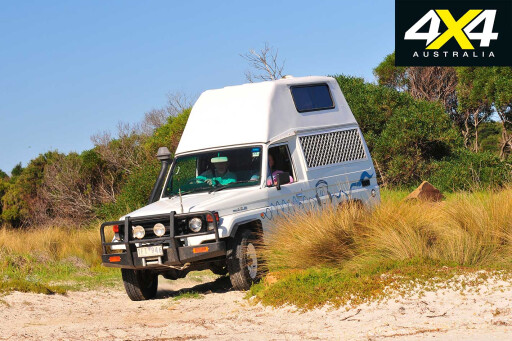 “When you go off the beaten track you are very vulnerable so you need to have yourself and the vehicle as fully prepared as possible so as not to rely on other people,” Chris says. “We have helped other people and when you ask, ‘Where’s your jumper leads?’ and they say, ‘We haven’t got any,’ it’s not really appreciated. You need to help yourself first.”
“When you go off the beaten track you are very vulnerable so you need to have yourself and the vehicle as fully prepared as possible so as not to rely on other people,” Chris says. “We have helped other people and when you ask, ‘Where’s your jumper leads?’ and they say, ‘We haven’t got any,’ it’s not really appreciated. You need to help yourself first.”
Lessons learned from experience go as far as carrying water, too. With the ongoing drought it’s no longer a case of just filling up the jerry cans with an endless free supply of the clear stuff. Thelma and Chris developed a new approach to water conservation they shared with many of the travellers they met along the road.
“The Troopie has a 45-litre water tank, but what we have as an emergency in the air space behind the passenger seat is a 10-litre jerry can for water,” Chris says. “We went into one town – Tibooburra, in NSW – and filled up with fuel. We said we needed water, but they didn’t have any to give. We realised then we are going to have to be more careful with the water.
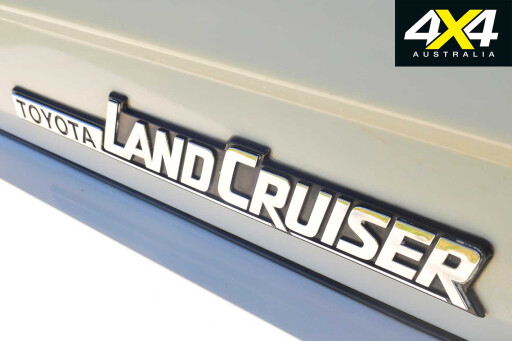 “One of the things we discovered on the Gibb River trip was because water was so scarce we didn’t use our shower, as the pump used too much water. A better system was to just do a flannel wash and then with a soft-drink bottle of water pour it over your head to rinse. It saved a lot of water.”
“One of the things we discovered on the Gibb River trip was because water was so scarce we didn’t use our shower, as the pump used too much water. A better system was to just do a flannel wash and then with a soft-drink bottle of water pour it over your head to rinse. It saved a lot of water.”
The Troopie has been a perfect vehicle for Thelma and Chris, who’ve chalked up uncounted memories from the places it has taken them. They’ve enjoyed helicopter flights over Lake Eyre, eaten barramundi in the Gulf country, camped beside the Pentecost River at El Questro, in the Kimberley, seen the Ground Zero Obelisk, west of Coober Pedy, where the atomic bombs were detonated, and much, much more.
They’ve even been caught in a major dust storm. “It was an adventure!” Thelma says. “It’s just being out in nature and having the clear sky with the stars and the sunrises and the sunsets. I think anyone would be in awe of those.”
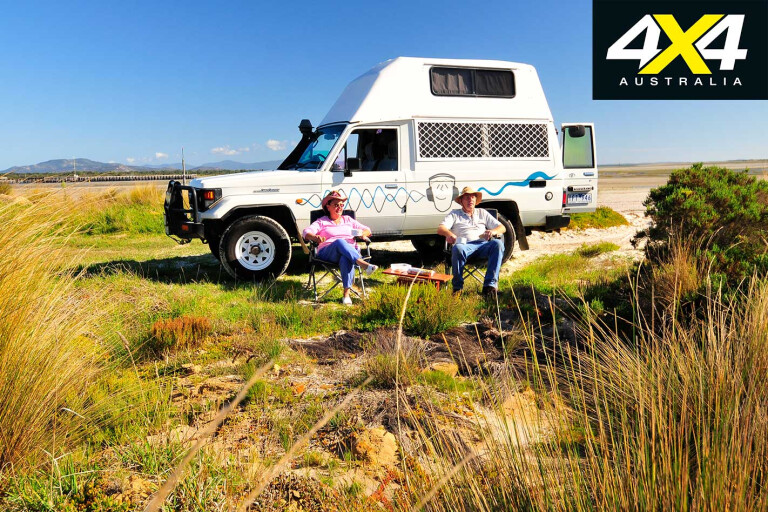
Chris Kyval's 4x4 Equipment Tips
Chris has thought long and hard about his recovery gear to ensure he gives himself every possible chance to avoid getting stuck in the middle of nowhere. Here’s what he uses.
- 3.5-tonne bullbar-mounted electric winch
- Lan-Cor ground anchor
- Air compressor
- Snatch strap, winch extension strap, snatch blocks, shackles
- Battery charger
- Tyre repair tools
- Two inner tubes (or plugs for fixing tubeless tyres)
- An exhaust jack
- Two mechanical jacks: “Sometimes when you get a flat tyre and it’s down low you can’t get the first jack under,” Chris says. “So you get one under in not the best position but just enough to raise it, then you slip the other one under.”
- Two wooden base plates for the jacks: “It gets you a better platform to work on.”
- Jumper leads for the battery: “Instead of putting them in the toolbox, I have a system where they are fastened underneath the bonnet. It keeps them where I need them and it’s using up air space. I’m utilising clips there that hold the two batteries.”
- Basic tool box of spanners and screwdrivers
- Test light to check for electrical faults
- Things like duct tape, wire fuses, spare fan belt, radiator hoses
- A reserve of water and food: “We never touched it but we knew it was there in case we had to hole up for a few days.”
- Satellite phone, UHF and GPS
- A list of telephone numbers with family, contacts, and also emergency services: “When you drive along there are big signs with warnings and saying, ‘If in trouble these are the numbers to ring’. Must make sure you write those numbers down.”

COMMENTS